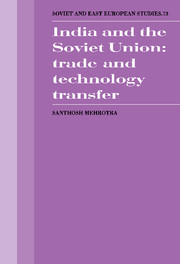7 - Bilateral payments
from PART III
Published online by Cambridge University Press: 04 August 2010
Summary
Bilateralism, with its emphasis on planning of imports and exports and bilateral balancing, suited the requirements of the CPEs' foreign trading system. When new trading arrangements with LDCs were established for the first time in the fifties, the CPEs of eastern Europe were already trading with each other on a bilateral basis. The CPEs' trade relations with LDCs were also established on a bilateral basis, and those which were not were gradually bilateralised. Like the LDCs, the CPEs were suffering from an acute shortage of convertible currencies. Hence, it was natural for the USSR's trade with India to have been on a bilateral basis.
This chapter on bilateral payments arrangements between India and the USSR attempts to answer the following questions:
Why does bilateralism (i.e. payments in rupees) still prevail in Indo- Soviet trade in the late eighties, although the CPEs have been multilateralising trading arrangements with most LDCs?
Since Soviet defence credits to India are repaid through bilateral trade, what has been the magnitude of defence-related payments by India to the USSR (between 1966/7 and 1985/6)? Calculations for the period up to the mid-sixties have already been made by Datar (1972). This whole subject is interesting because defence imports are possibly the single most important category of Indian imports from the USSR. To estimate defence-related payments, we attempt to reconstruct the balance of payments between India and the USSR since official statistics of neither country reveal balance of payments data with individual countries.
[…]
- Type
- Chapter
- Information
- India and the Soviet UnionTrade and Technology Transfer, pp. 141 - 160Publisher: Cambridge University PressPrint publication year: 1991



